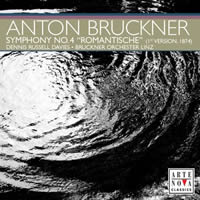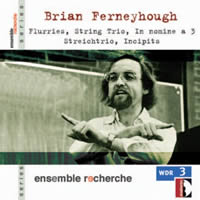Romantic, Impressionist, Complexist: Bruckner, Griffes, Ferneyhough
|
Dan Albertson [January 2006.]
Anton BRUCKNER: Symphony No. 4 in E-flat major, “Romantic” (orig. 1874 vers.). Bruckner-Orchester Linz, Dennis Russell Davies (cond.). Arte Nova Classics ANO 604880. Distributed in the US by Allegro Music (http://www.allegro-music.com/). His Fourth Symphony, noted especially for its distinctive hunting-call scherzo, is probably Bruckner’s most famous score. However, the refreshing version here presented is the first (premiered in 1975), with vastly different third and fourth movements. The course of the work seems to flow more effortlessly without the horn theme, as new orchestral signposts give the listener fresh perspectives into the wonders of the unchanged introductory Allegro and Andante quasi allegretto. The finale is a real sensation, closing this grand edifice with splendor, utilizing subtle reminders of the preceding movement. While it is not likely to replace the familiar later version in most listeners’ hearts, it offers an allure that will likely grow with time. The playing, as to be expected from a group dubbed the Bruckner-Orchester Linz, is top-notch. Maestro Davies, long one of my favorites in contemporary repertoire, continues to show his skill in a more traditional, but no less demanding, forum. This is a “live” recording, which seems almost unbelievable. Apart from some negligible noise between movements, the Austrian audience is clearly on its best behavior. Bravo to these engaged musicians and listeners!
Charles Tomlinson GRIFFES: Orchestral Music. Barbara Quintiliani (soprano); Carol Wincenc (flute); Buffalo Philharmonic Orchestra, JoAnn Falletta (cond.). Naxos 8.559164 (http://www.naxos.com/). A largely forgotten figure, Griffes died of influenza in 1920 at age 35. The composer is perhaps the first American to incorporate elements from Debussy into his music, an influence he acquired while studying in Europe. The works here are an ideal introduction to Griffes’ meager large-scale output, ranging from the moderately well-known Poem for Flute and String Orchestra and The White Peacock (like much of his music, originally for piano), to gems such as the sprightly Bacchanale and the tone-color study Clouds, another orchestration. This is music that reveals more of itself with each listen. The set of Three Poems by Fiona Macleod (sometimes given as Fiona MacLeod, but here misspelled McLeod throughout) is closer in style to Wagner. (The 1918 orchestration is by Mark Dresser, conductor of the Philadelphia Orchestra.) The songs are more than pleasant enough to merit listening. The purely instrumental Three Tone Pictures is equally charming and more characteristic of Griffes’ sound. The largest and grandest work is The Pleasure Dome of Kubla Khan, whose recurring brass motifs evoke Coleridge’s poetic façade with sublime majesty. This symphonic poem alone could secure Griffes’ reputation, which the other works further consolidate. More than an American Debussy or Scriabin, Griffes was an independent figure, capable of learning from his European contemporaries without replicating their idioms. Quintiliani handles her brief appearance superbly and the orchestra is dependable. In molding an ideal palette of gentle force and apropos sonic filigree, Falletta succeeds in all but a few minor passages, where the balance is tilted too much toward one group of instruments. Such occasional mistakes are not surprising, considering the music’s delicate nature and do not much detract from the performances’ effectiveness. Like the Bruckner, at budget price this is too good a deal to miss.
Brian FERNEYHOUGH: Chamber Music. Members of ensemble recherche. Stradivarius STR 33694 (http://www.stradivarius.it/). Distributed in the US by Allegro Music (http://www.allegro-music.com/). Any disc adding to Ferneyhough’s recorded catalogue automatically warrants an investigation. The opener is Flurries (1997-98), in which duos gradually multiply, until finally a sextet of piccolo, clarinet, horn, violin, cello and piano is attained, all the while yielding appealing, copiously multilayered sound combinations. The major work occupies nearly half the disc’s brief length: The 1995 String Trio, a truly captivating piece exploring a lengthy dialectic among violin, viola and cello, sometimes jovial but more frequently testy and bitter. The work’s level of tension, seemingly on the verge of crumbling, makes it an intensive and thrilling event that could easily repel tentative listeners. Then comes 2001’s In Nomine a 3, for piccolo, oboe and clarinet, an endearing evocation of Britain’s musical past, and the one-minute-plus Streichtrio from the previous year, jaunty and mercurial — and written using IRCAM’s Patchwork software, a first for the composer. The final work is Incipits (1996), a series of false starts for viola solo, percussion obbligato and sextet. Because the transitions are so very much legato, each fragmented “introduction” never draws attention to itself. It is also remarkable how vastly different Ferneyhough’s approach to the miniature form is compared to the master miniaturist György Kurtág, for whom the work’s 12 minutes are almost inconceivable. Bravura content and, as required, bravura performances reveal music so finely concatenated that it seems almost supernatural. One complaint about this thoroughly commendable addition to the catalogue: Why is it only 48 minutes long? There is so much else in the Ferneyhough repertoire requiring doing — and redoing — on disc.
[More Dan Albertson]
[Previous Article:
The Musical Moment]
[Next Article:
W.A. Mozart's Rondo for Piano, KV 511]
|


